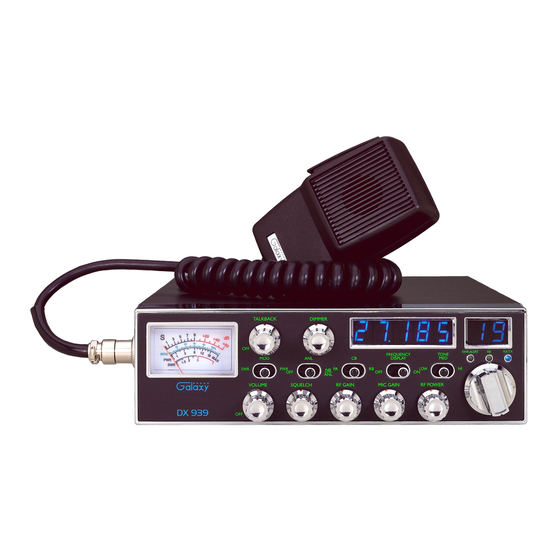Galaxy DX-939 Manuale d'uso - Pagina 7
Sfoglia online o scarica il pdf Manuale d'uso per Ricetrasmettitore Galaxy DX-939. Galaxy DX-939 11. Solid state citizens band am mobile transceiver with blue illuminated lite

PROCEDURE TO RECEIVE AND TRANSMIT
A. MICROPHONE
The receiver and transmitter are controlled by the push-to-talk switch on the
microphone. Press the switch and the transmitter is activated, release switch to
receive. When transmitting, hold the microphone two inches from the mouth and
speak clearly in a normal voice. This transceiver comes complete with a low
impedance dynamic microphone.
B. PROCEDURE TO RECEIVE
1. Be sure that power source, microphone and antenna are connected to the proper
connectors before going to the next step.
2. Turn unit on by running VOL knob clockwise on transceiver.
3. Set the VOL for a comfortable listening level.
4. Set the PA/CB switch to the CB mode.
5. Listen to the background noise from the speaker. Turn the SQ knob slowly
clockwise until the noise just disappears. Leave the control at this setting. This
SQ is now properly adjusted. The receiver will remain quiet until a signal is
actually received. Do not advance the control too far or some of weaker signals
will not be heard.
6. Set the CHANNEL selector switch to the desired channel.
7. Set the RF GAIN control fully clockwise for maximum receive gain.
C. RF POWER CONTROL
This feature allows for the adjustment of the RF power output continuously over
the range of 1 to 4 watts in AM.
D. PROCEDURE TO TRANSMIT
1. Select the desired channel of transmission
2. Set the MIC GAIN control fully clockwise.
3. If the channel is clear, depress the push-to-talk switch on the microphone and
speak in a normal voice.
- 12 -
ALTERNATE MICROPHONES AND INSTALLATION
For best results, the user should select a low-impedance dynamic type
microphone or a transistorized microphone. Transistorized type microphones have
low output impedance characteristics. The microphones must be provided with a
four-lead cable. The audio conductor and its shielded lead comprise two of the
leads. The third lead is for transmit control and fourth is for receiving control.
The microphone should provide the functions shown in schematic below.
4 WIRE MIC CABLE
Pin Number
1
2
3
4
Fig. 1 Your transceiver microphone schematic.
If the microphone to be used is provided with pre-cut leads, they must be revised
as follows.
1. Cut leads so that they extend 7/16" beyond the plastic insulating jacket of the
microphone cable.
2. All leads should be cut to the same length. Strip the ends of each wire 1/8" and
tin the exposed wire.
Mic Cable Lead
Audio Shield
Audio Lead
Transmit Control
Receive Control
- 13 -
